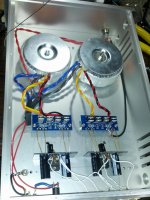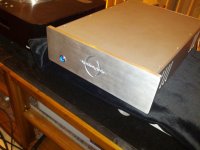I bought a premium LM3875 kit from Audio Sector quite a while ago. Despite the lousy MIC chassis and less-than-ideal connectors, my amp sang beautifully, well beyond my expectations.
After a few upgrades here and there over the years, I felt that the system is starting to outgrow my beloved Gainclone. Being infatuated with the sonic character of the amp, I wasn't ready to give in and "upgrade" to something else. It's not that I haven't heard my share of good amps, but those that clearly better my Gainclone are rather costly. Maybe not an arm and a leg costly, but already in the four-wheel range
So I decided to rebuild the LM3875, this time a maximum effort attempt. First, I replaced the standard issue Panasonic FCs with Nichicon VRs, and added the zobel network. The mods brought better lower end control, and smoother presentation. Not bad for $20 worth of components.
However, the biggest improvements came from TX2575 resistors (replaced the Caddock MK132s/Rikens at RF/R3), and 15VAC Nuvotem Talema toroids. Special thanks to WF, owner of CynicalAudio, for recommending the components.
If the LM3875 was a great amp for the cost and effort involved, now it's simply a great amp, regardless of price. The detail retrieval is almost mind-blowing. This level of resolution is one of the best I've heard, yet has none of the oft-associated harshness. Paired with my Audio Physic floorstands - with tweeters that theoretically goes up to 40k - I heard many things that I never knew existed in my favorite recordings! Coalesced with the transparent, spacious, and smooth presentation, the result is a very refined sound that rivals the Germanic gods... er, hi-end amps.
As a matter of fact, I brought the amp to a good friend of mine, who happens to be a local hi-end dealer (and soon-to-be agent). He was mightily impressed, and half-jokingly asked me not to show up with the amp when customers are around, or he'll hold me responsible for unsaleable goods!
I was so happy with the sound that I HAD to put the amp in a pretty, customized box. The "logo" is an obvious reference to my favorite band, and has a not-so-modest underlying meaning: APC also stands for "a perfect clone"
Thank you for reading!
Alex
After a few upgrades here and there over the years, I felt that the system is starting to outgrow my beloved Gainclone. Being infatuated with the sonic character of the amp, I wasn't ready to give in and "upgrade" to something else. It's not that I haven't heard my share of good amps, but those that clearly better my Gainclone are rather costly. Maybe not an arm and a leg costly, but already in the four-wheel range
So I decided to rebuild the LM3875, this time a maximum effort attempt. First, I replaced the standard issue Panasonic FCs with Nichicon VRs, and added the zobel network. The mods brought better lower end control, and smoother presentation. Not bad for $20 worth of components.
However, the biggest improvements came from TX2575 resistors (replaced the Caddock MK132s/Rikens at RF/R3), and 15VAC Nuvotem Talema toroids. Special thanks to WF, owner of CynicalAudio, for recommending the components.
If the LM3875 was a great amp for the cost and effort involved, now it's simply a great amp, regardless of price. The detail retrieval is almost mind-blowing. This level of resolution is one of the best I've heard, yet has none of the oft-associated harshness. Paired with my Audio Physic floorstands - with tweeters that theoretically goes up to 40k - I heard many things that I never knew existed in my favorite recordings! Coalesced with the transparent, spacious, and smooth presentation, the result is a very refined sound that rivals the Germanic gods... er, hi-end amps.
As a matter of fact, I brought the amp to a good friend of mine, who happens to be a local hi-end dealer (and soon-to-be agent). He was mightily impressed, and half-jokingly asked me not to show up with the amp when customers are around, or he'll hold me responsible for unsaleable goods!
I was so happy with the sound that I HAD to put the amp in a pretty, customized box. The "logo" is an obvious reference to my favorite band, and has a not-so-modest underlying meaning: APC also stands for "a perfect clone"
Thank you for reading!
Alex
Attachments
Last edited:
Hi Alex,
I'd like to try some of the same parts you used to get your gainclones up to such a high level. Can you give me the exact specs on those Nuvotem Talema toroids?
Thanks
Me too~
May I have the part no. ? Prepare to make my first GC~
Thanks!
Hi Bill,
The transformers I use are Nuvotem 91959-P2S2, 160VA@15V. It's possible to go for larger ones, but I found it hard to justify the added size and cost. The voltage, however, is highly dependent on speakers and personal taste. Peter recommends a value close to 25V, which - from his standpoint - is sound advice for most. Gainclone(card)s are notoriously "picky", and a higher working voltage increases their chance of playing nice.
If you don't mind shopping for speakers to match the GC like I did, then lower voltages may be sonically rewarding. To quote Pedja Rogic, a lower supply voltage results in "[a] more natural, more transparent, quieter sound with better resolution". Though do keep in mind that lowering the voltage may lead to a slight decrease in dynamics, "liveliness", and low end control.
The transformers I use are Nuvotem 91959-P2S2, 160VA@15V. It's possible to go for larger ones, but I found it hard to justify the added size and cost. The voltage, however, is highly dependent on speakers and personal taste. Peter recommends a value close to 25V, which - from his standpoint - is sound advice for most. Gainclone(card)s are notoriously "picky", and a higher working voltage increases their chance of playing nice.
If you don't mind shopping for speakers to match the GC like I did, then lower voltages may be sonically rewarding. To quote Pedja Rogic, a lower supply voltage results in "[a] more natural, more transparent, quieter sound with better resolution". Though do keep in mind that lowering the voltage may lead to a slight decrease in dynamics, "liveliness", and low end control.
Me too~
May I have the part no. ? Prepare to make my first GC~
Thanks!
Hi Fred,
I'll send you a PM after I find time to look them up.
Alex,
Thanks for the information on the transformer, that's extremely helpful. Especially the part about how the supply voltage affects the sound. I've been going through the gainclone threads, but it's hard to find that kind of knowledge amidst the hundreds of pages of postings.
I have a few more questions if you're willing to help:
1) What kind of speakers work best with the Gainclone?
2) Is that black box I see extending from the underside of the amp board in your picture the zobel network? Where do you get something like that?
3) I've seen Gainclone schematics that list the capacitance used on the amp board as either .10 uF, or 10 uF, or 1000 uf. Do you know what the effect of using different values of capacitance has on the sound?
4) Has anyone tried using high end capacitors like V-Caps in this circuit?
Thanks very much!
Bill
Thanks for the information on the transformer, that's extremely helpful. Especially the part about how the supply voltage affects the sound. I've been going through the gainclone threads, but it's hard to find that kind of knowledge amidst the hundreds of pages of postings.
I have a few more questions if you're willing to help:
1) What kind of speakers work best with the Gainclone?
2) Is that black box I see extending from the underside of the amp board in your picture the zobel network? Where do you get something like that?
3) I've seen Gainclone schematics that list the capacitance used on the amp board as either .10 uF, or 10 uF, or 1000 uf. Do you know what the effect of using different values of capacitance has on the sound?
4) Has anyone tried using high end capacitors like V-Caps in this circuit?
Thanks very much!
Bill
Hi Bill,
Glad you found it helpful.
As for your questions:
1) The general rule is the simpler and the higher efficiency, the better. Though in my personal experience, it's best to audition each one (pair) of them. Take the ALR Note 3 for an example, they're 2-way speakers rated at 90db, which are supposedly easier on amps than my Audio Physic 3-way 89db ones. But in reality, my gainclone has a much harder time driving the former.
2) The zobel on my gainclone consists of 10R audio note tantalums and 0.01uf Rel-Cap RTEs (the black boxes). Those are the values used on the original GainCard.
3) Peter's boards and schematic are a great starting point. Tweak to fit your system and taste. I personally use 2200uf/50Vx2 on each board.
4) If your source is AC coupled (make sure!), no cap is better than any "hi-end" cap.
If auditioning is difficult, it's hard to go wrong with full range speakers. They are, after all, the only type of speakers sold by 47 Labs.
Glad you found it helpful.
As for your questions:
1) The general rule is the simpler and the higher efficiency, the better. Though in my personal experience, it's best to audition each one (pair) of them. Take the ALR Note 3 for an example, they're 2-way speakers rated at 90db, which are supposedly easier on amps than my Audio Physic 3-way 89db ones. But in reality, my gainclone has a much harder time driving the former.
2) The zobel on my gainclone consists of 10R audio note tantalums and 0.01uf Rel-Cap RTEs (the black boxes). Those are the values used on the original GainCard.
3) Peter's boards and schematic are a great starting point. Tweak to fit your system and taste. I personally use 2200uf/50Vx2 on each board.
4) If your source is AC coupled (make sure!), no cap is better than any "hi-end" cap.
If auditioning is difficult, it's hard to go wrong with full range speakers. They are, after all, the only type of speakers sold by 47 Labs.
- Status
- This old topic is closed. If you want to reopen this topic, contact a moderator using the "Report Post" button.
- Home
- More Vendors...
- Audio Sector
- What Glitters is Gold! My LM3875 rebuild

